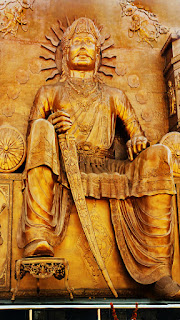Which Indian king had the biggest empire in history?
Outline of the Article:
Introduction
Early Indian Empires
The Maurya Empire
The Gupta Empire
Rise of the Chola Dynasty
The Extent of the Chola Empire
Territories and Conquests
Maritime Trade and Diplomacy
Administration and Governance
Central Administration
Local Administration
Cultural and Artistic Achievements
Architecture and Temples
Literature and Poetry
Decline and Aftermath
Factors for Decline
Legacy of the Chola Empire
Conclusion
FAQs
Which Indian king had the biggest empire in history?
Introduction:
India has a rich history of powerful dynasties that have left a lasting impact on the subcontinent. Many Indian kings and empires rose to prominence and expanded their territories over the centuries. One of the most influential and expansive empires in Indian history was the Chola Empire. Let's explore the rise, extent, administration, and cultural achievements of the Chola Dynasty, which held the title of having the biggest empire in ancient Indian history.
Early Indian Empires:
The Maurya Empire:
The Maurya Empire, founded by Chandragupta Maurya in the 4th century BCE, was one of the earliest and most significant empires in Indian history. However, in terms of territorial expansion, it was not as vast as the later Chola Empire.
The Gupta Empire:
The Gupta Dynasty, ruling from the 4th to the 6th century CE, is often referred to as the "Golden Age" of India. While it was a prosperous empire, it did not encompass the vast territories that the Chola Empire later did.
Rise of the Chola Dynasty:
The Chola Dynasty, originating in the fertile region of the Kaveri River basin in present-day Tamil Nadu, rose to power around the 9th century CE. The Cholas were skilled naval warriors and traders, which played a crucial role in their territorial expansion.
The Extent of the Chola Empire:
Territories and Conquests:
Under the rule of prominent Chola kings like Rajaraja Chola I and Rajendra Chola I, the empire expanded rapidly. They conquered vast territories in South India, including regions now comprising Tamil Nadu, Kerala, parts of Andhra Pradesh, and Karnataka. Beyond the Indian mainland, the Cholas also extended their influence over Sri Lanka, the Maldives, and parts of Southeast Asia.
Maritime Trade and Diplomacy:
The Chola Empire was well-known for its maritime prowess. Their naval expeditions facilitated extensive trade networks, enhancing cultural exchanges and diplomatic ties with neighboring empires and distant lands.
Administration and Governance:
Central Administration:
The Chola rulers maintained a centralized administrative system, with the king at the helm. Efficient governance and a well-organized bureaucracy allowed for effective management of the vast empire.
Local Administration:
The Cholas had a decentralized system of governance, granting significant autonomy to local rulers. This approach fostered a sense of loyalty and cooperation among the subjects.
Cultural and Artistic Achievements:
Architecture and Temples:
The Chola period is renowned for its splendid temple architecture. The Brihadeeswarar Temple in Thanjavur, built by Rajaraja Chola I, stands as a masterpiece of Chola architecture and a UNESCO World Heritage site.
Literature and Poetry:
The Cholas were great patrons of literature and poetry. They contributed to Tamil literature, and their court was adorned with talented poets and scholars.
Decline and Aftermath:
Factors for Decline:
Like many other empires, the Chola Dynasty faced challenges, including internal rebellions and external invasions, which eventually led to its decline.
Legacy of the Chola Empire:
Despite its decline, the Chola Empire's legacy endured through its architectural marvels, cultural achievements, and maritime influence, leaving an indelible mark on Indian history.
Conclusion:
The Chola Empire, with its exceptional military might, maritime dominance, and cultural brilliance, holds a prominent place in Indian history. Their vast territorial expansion, administrative prowess, and contributions to art and literature make them one of the most significant Indian empires of all time.
FAQs:
Q: Who was the greatest Chola king?
A: Rajaraja Chola I is often considered the greatest Chola king due to his successful reign and architectural marvels.
Q: How did the Chola Empire decline?
A: The decline of the Chola Empire was triggered by internal rebellions and external invasions.
A: The Brihadeeswarar Temple symbolizes the architectural brilliance of the Chola period and is a UNESCO World Heritage site.
Q: Did the Chola Empire have any diplomatic relations?
A: Yes, the Cholas had extensive diplomatic relations through their maritime trade and cultural exchanges with neighboring empires and distant lands.
Q: What is the lasting legacy of the Chola Dynasty?
A: The Chola Dynasty's legacy endures through their cultural contributions, architectural marvels, and influence on trade and diplomacy in the Indian Ocean region.

.jpg)



No comments:
Post a Comment